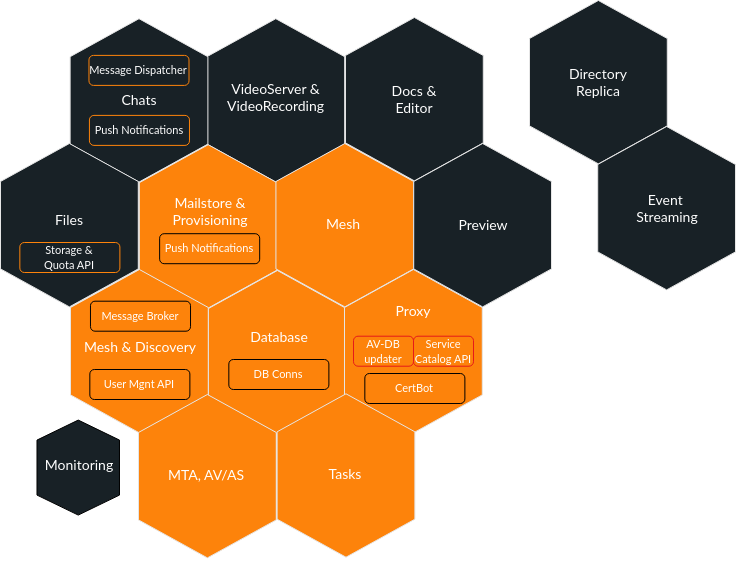Architecture of Carbonio#
This section contains a description of Carbonio architecture and of the Components along with the features they provide.

Fig. 1 Simplified architecture of Carbonio.#
Fundamental Concepts#
Carbonio is built on a multi-component architecture. Each component is responsible for a specific part of the collaboration suite and can be installed on a Single Node or distributed across multiple Nodes depending on the desired level of performance, scalability, and redundancy.
Core and Collaboration Components#
Within the collection of Components, we can distinguish:
Core Components
These are required for the basic operation of Carbonio:
MTA AV/AS: Sending and receiving emails
Mailstore & Provisioning: Account provisioning and message storage
Proxy: Web access
Database / Mesh & Directory: Backend services required for infrastructure operation
Collaboration Components
These add advanced collaboration and communication features to Carbonio:
Files
Chats
Docs & Editor
Tasks
Preview
Video Server & Video Recording
Additional Components and Monitoring
Some components serve special purposes:
Monitoring: Centralising metrics with dashboards tailored for Carbonio
Redundancy (optional): needed in specific installation scenarios, they include Directory Replica and Event Streaming
List of the Main Carbonio Packages#
Below is the list of Carbonio packages collected by component and updated to version 25.6.0.
Note
Click each Component section below to see the packages that make it up.
Mesh & Directory
service-discover-server: service-discover-server (0.2.2)
carbonio-directory-server: carbonio-directory-server (4.23.1)
carbonio-message-broker: carbonio-message-broker (0.2.2)
carbonio-storages: carbonio-storages (0.0.16)
carbonio-user-management: carbonio-user-management (0.8.4)
Database
carbonio-ws-collaboration-db: carbonio-ws-collaboration-db (0.2.4)
carbonio-message-dispatcher-db: carbonio-message-dispatcher-db (0.2.3)
carbonio-notification-push-db: carbonio-notification-push-db (0.1.3)
carbonio-files-db: carbonio-files-db (0.1.7)
carbonio-mailbox-db: carbonio-mailbox-db (0.2.2)
carbonio-docs-connector-db: carbonio-docs-connector-db (0.0.3)
carbonio-tasks-db: carbonio-tasks-db (0.0.4)
Proxy
carbonio-proxy: carbonio-proxy (4.9.3)
carbonio-catalog: carbonio-catalog (0.0.2)
carbonio-files-public-folder-ui: carbonio-files-public-folder-ui (0.0.9)
carbonio-webui: carbonio-webui (4.4.3)
carbonio-tasks-ui: carbonio-tasks-ui (0.0.17)
carbonio-files-ui: carbonio-files-ui (2.13.2)
carbonio-ws-collaboration-ui: carbonio-ws-collaboration-ui (0.9.17)
carbonio-avdb-updater: carbonio-avdb-updater (1.0.5)
MTA
carbonio-mta: carbonio-mta (4.2.1)
Mailstore & Provisioning
carbonio-advanced: carbonio-advanced (4.24.4-1)
carbonio-zal: carbonio-zal (4.25.0-1)
Files
carbonio-files: carbonio-files (0.17.0)
Docs & Editor
carbonio-docs-editor: carbonio-docs-editor (25.04.3)
carbonio-docs-connector: carbonio-docs-connector (0.8.2)
Preview
carbonio-preview: carbonio-preview (0.4.5)
Tasks
carbonio-tasks: carbonio-tasks (0.5.3)
Chats
carbonio-message-dispatcher: carbonio-message-dispatcher (0.15.3)
carbonio-ws-collaboration: carbonio-ws-collaboration (1.6.2)
carbonio-push-connector: carbonio-push-connector (0.1.4)
carbonio-notification-push: carbonio-notification-push (0.2.2)
Video Server & Video Recording
carbonio-videoserver-advanced: carbonio-videoserver-advanced (2.0.13)
carbonio-videorecorder: carbonio-videorecorder (1.2.0)
Monitoring
carbonio-prometheus: carbonio-prometheus (3.5.0)
Component Communication#
All components communicate over Carbonio Mesh, a secure internal service layer that provides:
Service discovery
Automatic configuration propagation
Secure RPC over HTTP/HTTPS
External clients (webmail, mobile apps, third-party clients) typically interact through the Proxy node which routes the traffic to internal services.
Accessing Carbonio Services#
Once the installation is completed, Carbonio features are available via:
The main webmail interface, see Section Access to the Web Interface
Carbonio mobile apps (Mail, Files, and Chats)
Third-party clients
Supported protocols include:
POP3 and POP3S
SMTP and SMTPS (SMTP over TLS/SSL)
IMAP and IMAPS (IMAP over SSL)
ActiveSync
LDAP (for external address books)
CalDAV
CardDAV